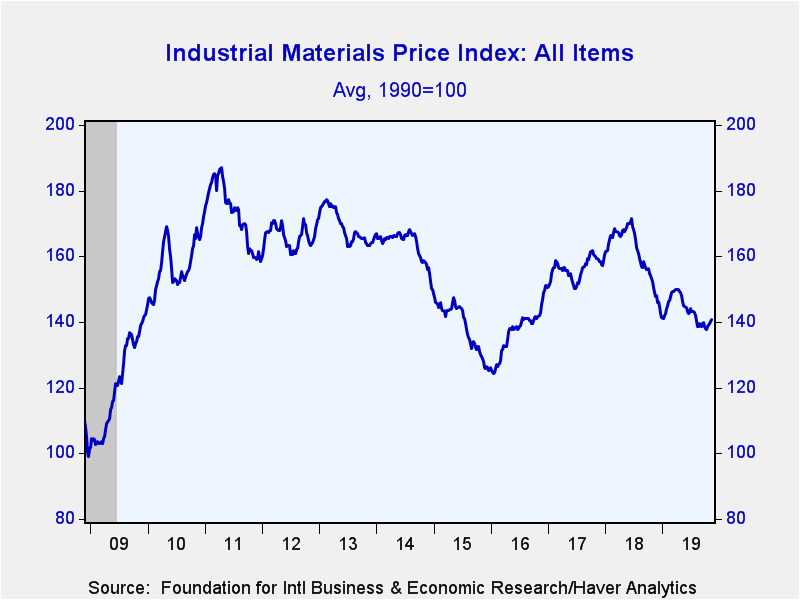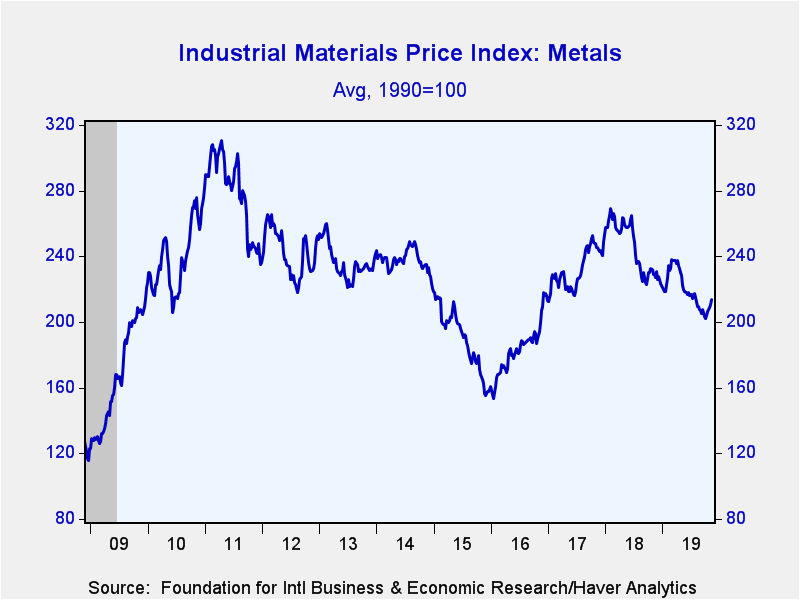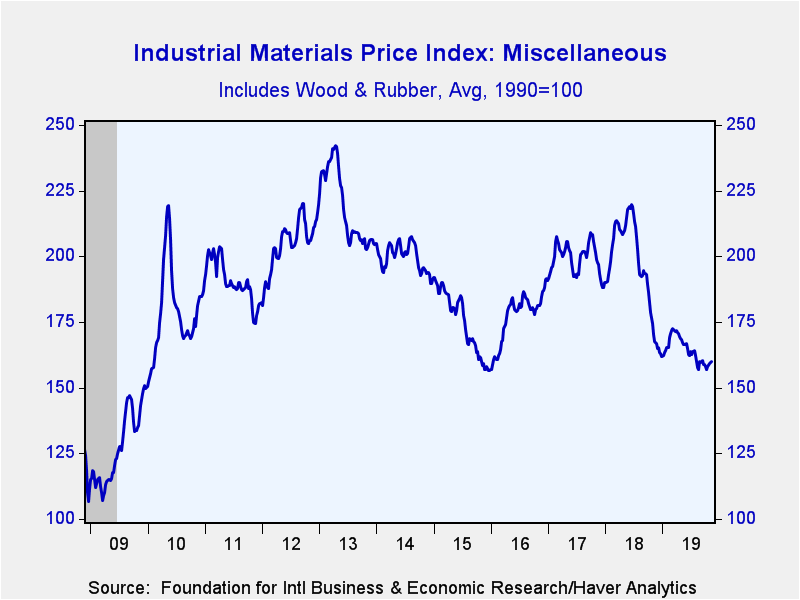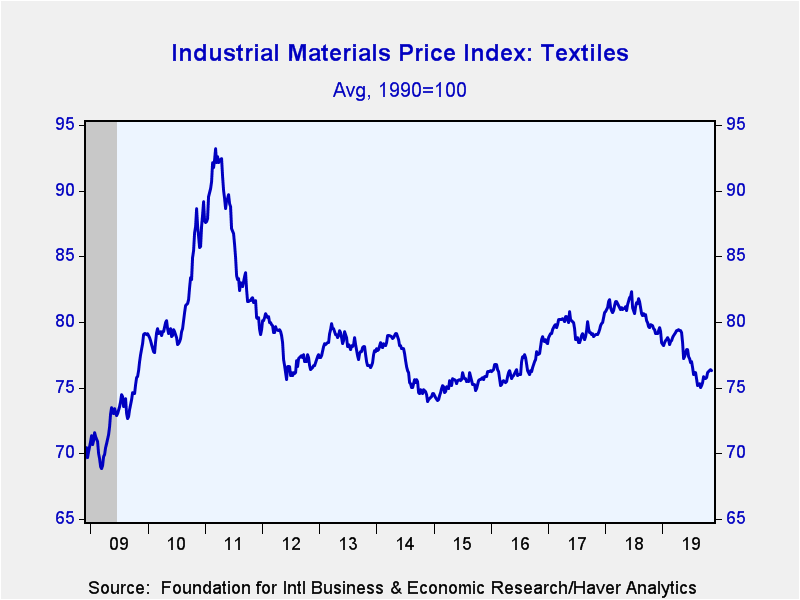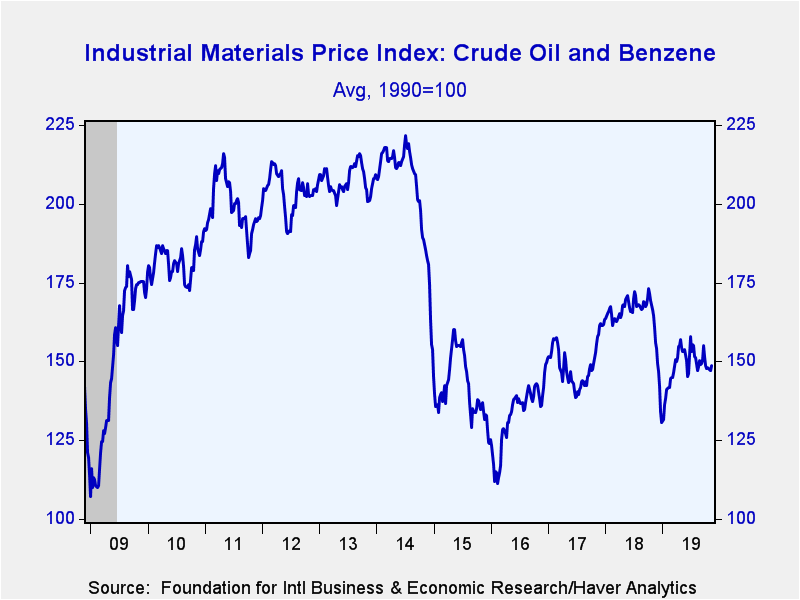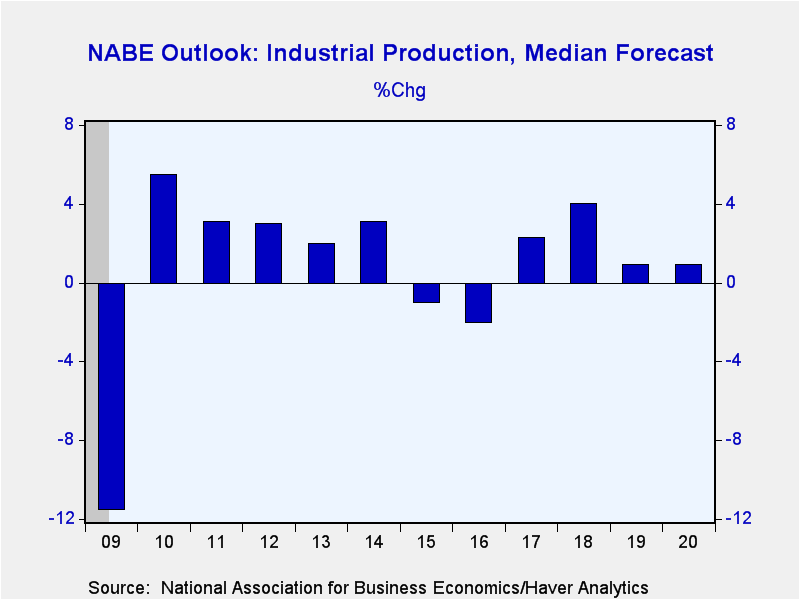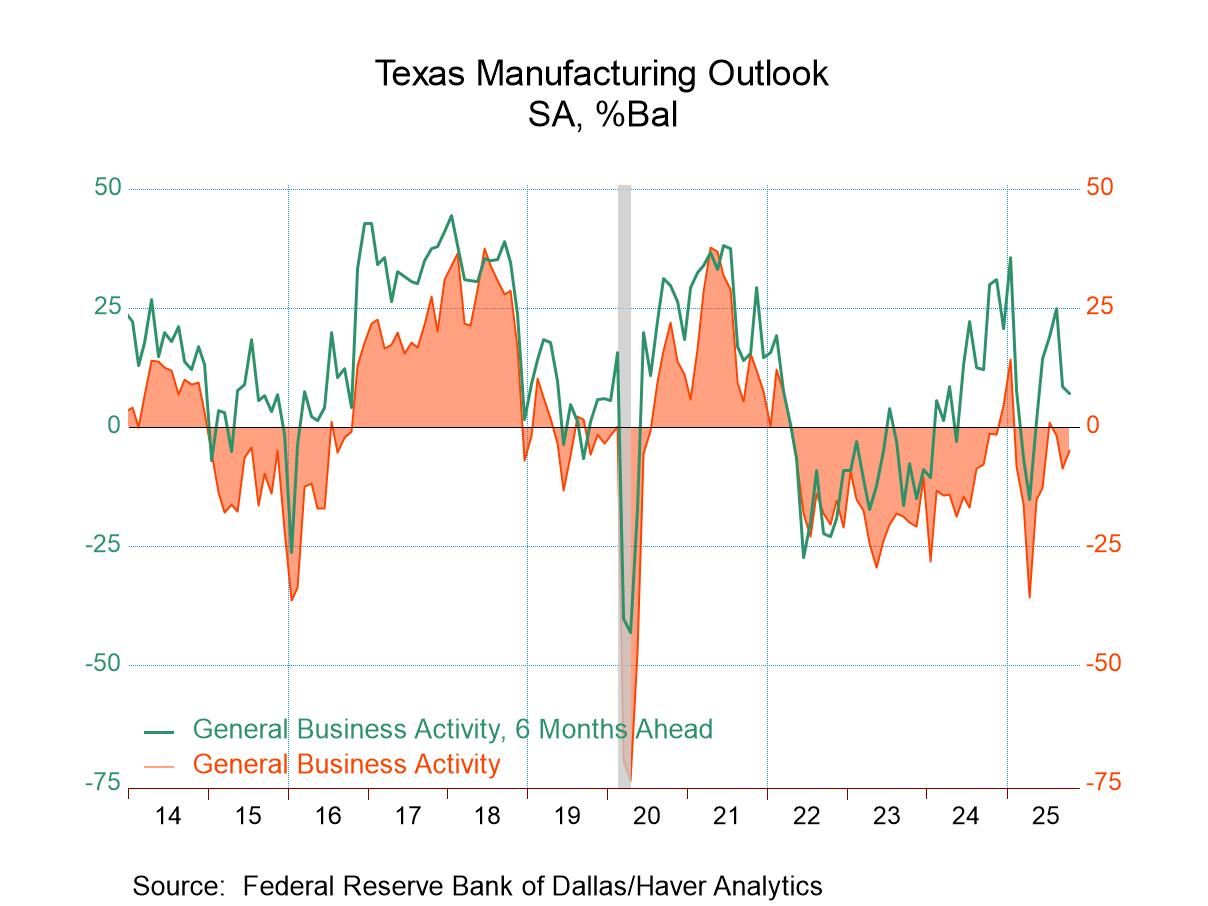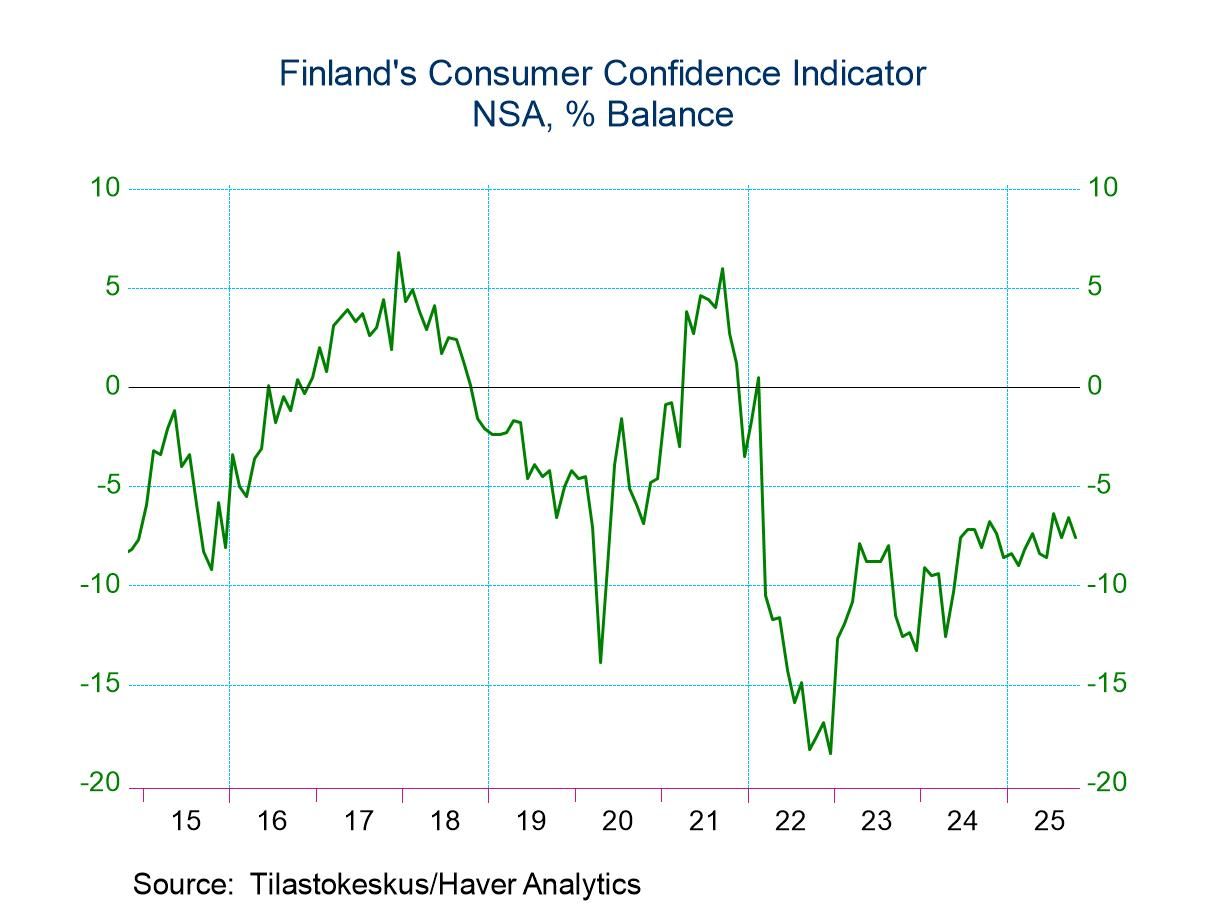 Global| Nov 11 2019
Global| Nov 11 2019FIBER: Industrial Commodity Prices Rise
by:Tom Moeller
|in:Economy in Brief
Summary
Recent improvement in factory production lent some life to pricing power in the sector. The Industrial Materials Price Index from the Foundation for International Business and Economic Research (FIBER) increased 2.2% during the last [...]
Recent improvement in factory production lent some life to pricing power in the sector. The Industrial Materials Price Index from the Foundation for International Business and Economic Research (FIBER) increased 2.2% during the last four weeks and 1.6% over the last three months. Nevertheless, the price index was down 5.5% y/y.
The degree of four-week price improvement varied greatly amongst product groupings. Prices in the metals grouping showed the most strength with a 4.8% rise over the last month as the cost of steel scrap surged 11.5%. Zinc prices also exhibited life with an 9.5% rise in four weeks (-0.2% y/y) and the cost of aluminum improved 4.5%. Copper scrap prices rose 4.0% last month, but lead prices eased 0.3% (+11.0% y/y). Prices in the miscellaneous grouping rose 1.9% as the cost of framing lumber jumped 7.7% and prices for natural rubber prices improved 4.4%. Structural panel prices held steady last month, but were down a lessened 15.2% y/y. Prices in the textile group improved 0.7% during the last month as cotton prices strengthened 3.9% m/m. Burlap prices improved 0.6% in the last month (-7.6% y/y). Prices in the crude oil & benzene category rose 0.6% m/m as crude oil prices rose to $56.63 per barrel by the end of the month. Nevertheless, they remained well below the early-October peak of $75.05. A 9.4% four-week decline (-20.4% y/y) in the cost of petro-chemical benzene offset this strength.
Commodity prices could remain weak over the short term. U.S. factory output growth is projected to slow and recessions abroad are continuing. The consensus forecast from the National Association for Business Economics (NABE) calls for a modest 0.9% rise in industrial production both this year and next. During the last ten years, there has been a 71% correlation between the y/y change in industrial commodity prices and the y/y change in factory sector output.
Commodity price data can be found in Haver's DAILY, WEEKLY, USECON and CMDTY databases. The NABE forecast is in the SURVEYS database.
Why Climate Change Matters for Monetary Policy and Financial Stability from Fed Governor Lael Brainard can be found here.
| FIBER Industrial Materials Price Index (%) | 1-Mth | 3-Mth | 6-Mth | 12-Mth | 2018 | 2017 | 2016 |
|---|---|---|---|---|---|---|---|
| All Items | 2.2 | 1.6 | -3.7 | -5.5 | -12.0 | 6.7 | 19.2 |
| Textiles | 0.7 | 1.5 | -2.8 | -4.0 | -2.8 | 3.0 | 2.8 |
| Cotton (cents per pound) | 3.9 | 14.3 | -9.7 | -18.4 | -9.2 | 9.8 | 10.2 |
| Metals | 4.8 | 2.2 | -3.9 | -6.6 | -12.2 | 18.6 | 32.9 |
| Aluminum ($ per metric ton) | 4.5 | 3.5 | 1.6 | -8.2 | -12.7 | 26.0 | 13.0 |
| Copper Scrap (cents per pound) | 4.0 | 3.2 | -4.5 | -5.4 | -16.1 | 29.3 | 17.3 |
| Steel Scrap ($ per ton) | 11.5 | -8.7 | -10.7 | -21.8 | 2.3 | 16.8 | 74.5 |
| Crude Oil & Benzene | 0.6 | 0.9 | -2.9 | -7.5 | -20.0 | 8.1 | 20.4 |
| Crude Oil (WTI, $ per Barrel) | 7.0 | 4.9 | -8.6 | -8.7 | -24.4 | 10.9 | 44.3 |
| Miscellaneous | 1.9 | 1.4 | -4.4 | -4.7 | -14.8 | -0.5 | 21.7 |
| Framing Lumber ($ per 1000 board ft.) | 7.7 | 13.6 | 11.3 | 16.6 | -23.1 | 20.0 | 12.9 |
| Natural Rubber (cents per pound) | 4.4 | 0.8 | -13.8 | 4.9 | -4.1 | -29.6 | 89.4 |
Tom Moeller
AuthorMore in Author Profile »Prior to joining Haver Analytics in 2000, Mr. Moeller worked as the Economist at Chancellor Capital Management from 1985 to 1999. There, he developed comprehensive economic forecasts and interpreted economic data for equity and fixed income portfolio managers. Also at Chancellor, Mr. Moeller worked as an equity analyst and was responsible for researching and rating companies in the economically sensitive automobile and housing industries for investment in Chancellor’s equity portfolio. Prior to joining Chancellor, Mr. Moeller was an Economist at Citibank from 1979 to 1984. He also analyzed pricing behavior in the metals industry for the Council on Wage and Price Stability in Washington, D.C. In 1999, Mr. Moeller received the award for most accurate forecast from the Forecasters' Club of New York. From 1990 to 1992 he was President of the New York Association for Business Economists. Mr. Moeller earned an M.B.A. in Finance from Fordham University, where he graduated in 1987. He holds a Bachelor of Arts in Economics from George Washington University.


